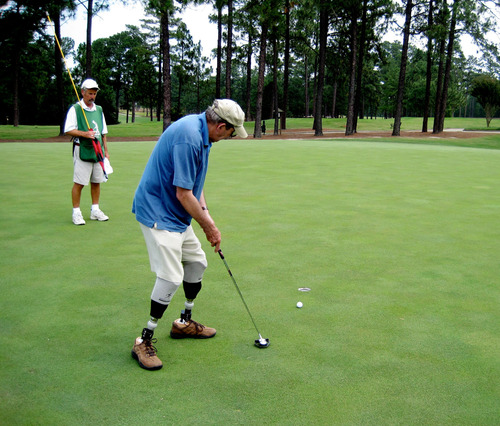Double amputee doesn’t let illness stop him from enjoying life


Retiree Bill Spiker has always enjoyed cycling, golfing, skiing, kayaking, windsurfing and sculpting metal. A former advertising and public relations consultant, Spiker hoped to fervently pursue these hobbies in retirement. That changed in 2008, when he was diagnosed with leukemia. Treatment, including a bone marrow transplant, successfully eradicated the cancer – but also devastated his immune system. His recovery required rebuilding his immune system with a lifetime’s worth of immunizations.
A sudden fever in January 2011 sent Spiker to the hospital, where he was diagnosed with septic shock (pneumococcal strep), a severe infection involving all the vital organs. Antibiotics slowed the attack, but not in time to prevent gangrene in his hands and feet. Both legs and some of his fingers to the first joint were amputated.
Following surgery, Spiker was admitted to the Christiana Care Center for Rehabilitation at Wilmington Hospital – a hospital within a hospital for patients recovering from major injury or illness – to learn how to walk and regain independence in daily activities. Working with his rehabilitation physician and multidisciplinary rehabilitation team, Spiker began an intensive program to rebuild strength and function.
Occupational therapists helped him practice activities of daily living such as bathing and getting dressed. According to Kelly Eschbach, M.D., a rehabilitation physician at the Center for Rehabilitation, Spiker succeeded because he believed and participated in his recovery. With his therapists, he set and achieved goals.
On March 1 – just a handful of weeks later, Spiker was independent enough to return home with the help of visiting nurses. His home setting was adapted for his wheelchair and to accommodate his remaining physical limitations, and he received continued physical therapy at home.
Even with a setback in April due to blood clots in his lungs (pulmonary embolism), he began outpatient therapy with Rehabilitation Services at Wilmington Hospital in May. He still has some residual phantom pain and “awakening” sensations, and uses biofeedback to get a sense of movement and distance to the ground, but his ability has considerably improved.
With his new “feet” – prosthetic limbs – he quickly progressed from walker to cane. His persistence paid off in June when he went to Pinehurst, N.C., for four days of chipping, putting and riding in a golf cart. He does admit to using a putter for a cane at times, though he is able to walk without it.
At home, he is again active. He drives with hand controls and is back in his workshop welding metal sculptures. He has returned to kayaking on local waterways.
Spiker has the highest praise for Dr. Eschbach, the physical and occupational therapists and nurses at the Center for Rehabilitation at Wilmington. He attributes his return to active life to “their outstanding professionalism, encouragement and dedication to patients’ progress. They were the most important factors in shortening my rehabilitation and hospital stays.”